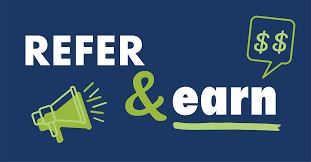
Employee Referral Bonus: Boosting Employee Engagement and Recruitment
Our organization strongly believes that happy employees make for a thriving business. And what better way to boost employee satisfaction than by rewarding them for referrals that result in successful hires? In this article, we’ll dive into employee and referral bonus programs, bonuses’ details, how they work, and why they’re an effective tool for employee engagement and recruitment.
What is an Employee Referral Bonus?
An employee referral bonus (ERB) is a type of incentive program companies offer to their employees to refer qualified candidates for job openings. The employee who refers the candidate receives a bonus if the referral results in a successful hire. ERBs can vary in terms of the bonus amount and the specific requirements for eligibility, such as the position level, job function, or location of the referred employee.
Why Offer an Employee Referral Bonus?
ERBs offer several benefits for both employees and employers. For employees, ERBs provide a financial incentive that motivates them to refer qualified candidates, leading to increased engagement and satisfaction in their roles. Additionally, employees who refer candidates may feel a sense of pride in helping their company grow and succeed.
For employers, ERBs are a cost-effective way to source high-quality candidates. According to a study by Jobvite, employee referrals are the top source of hires, with 40% of all hires coming from employee referrals. Additionally, referrals tend to be a better cultural fit and have a higher retention rate than other sources of hires.
How to Implement an Employee Referral Bonus Program
Implementing an ERB program requires careful planning and consideration. Here are some steps to follow:
Set clear eligibility criteria: Determine which positions are eligible for the referral programs and bonuses and any specific requirements, such as length of employment or performance metrics.
Establish bonus amounts: Decide on the bonus amount for each successful referral. This amount can vary depending on the position level of referred candidates, the hiring demand for that role, and other factors.
Communicate the program to employees: Communicate the details of the program referring employees, including eligibility criteria, bonus amounts, and how to make a referral.
Track referrals and payouts: Establish a system for tracking referrals and bonus payouts, such as an online portal or spreadsheet.
Evaluate and adjust the program: Regularly evaluate its effectiveness and adjust as needed to ensure it achieves its goals.
Employee referral bonuses are a win-win for both employees and employers. They offer financial incentives for employees to refer high-quality candidates, leading to increased engagement and satisfaction and cost-effective hiring for employers. In addition, organizations can boost employee engagement and recruitment success by implementing referral bonus ranges and a well-planned ERB program.

Additional Considerations for a Successful Employee Referral Bonus Program
While setting up an ERB program may seem straightforward, additional considerations exist for a successful program. Here are a few tips:
Ensure the bonus amount is competitive: If the bonus amount is too low, employees may not be motivated to make referrals. Research industry standards for types of referral bonuses and adjust the bonus amount accordingly.
Be transparent about the hiring process: Employees should clearly understand the hiring process and the criteria for a successful employee referral program. Employees who feel that referrals are not considered relatively may disengage from the program.
Encourage referrals that employees refer candidates from diverse sources: While employee referrals are an effective source of hires, they can also lead to a lack of diversity in the candidate pool. Therefore, encourage employees to refer candidates from various backgrounds and origins.
Don’t forget about unsuccessful referrals: While ERBs typically only reward employees for successful referrals, it’s essential also to acknowledge and thank employees for unsuccessful referrals. This can help maintain engagement and motivation in the program.
Continuously promote the referral program: ERBs can be easy to forget about, so it’s important to continuously promote the program and remind employees of the benefits of making referrals.

How to Implement an Employee Referral Bonus Program
Implementing an employee referral bonus (ERB) program can be a straightforward process if you follow a few key steps:
Establish eligibility criteria: Determine which employees can participate in the program. For example, some organizations may limit eligibility to specific departments or job levels, while others may open the program to all employees.
Determine the bonus amount: Decide how much the average employee referral bonus will be for a successful referral. This amount can vary based on the position level being filled, the difficulty of finding qualified candidates, and the organization’s budget.
Communicate the program: Communicate the program to employees, including the eligibility criteria, bonus amount, and referral process. This can be done through email, the company intranet, or during team meetings.
Establish a referral process: Create a clear and straightforward method for employees to make referrals. This may include an online referral form or a designated contact person to submit referrals.
Track referrals and payouts: Keep track of all referrals and payouts to ensure the program runs smoothly and fairly. Use a tracking system to monitor the status of referrals and payments and make adjustments as needed.
Evaluate the program: Regularly evaluate the ERB program’s success to identify improvement areas. Collect feedback from employees and hiring managers and adjust the eligibility criteria, bonus amount, or referral process as needed.
By following these steps, organizations can establish a successful ERB program that engages existing employees in recruitment and leads to higher-quality hires.

The Benefits of an Employee Referral Bonus Program
Implementing an employee referral bonus (ERB) program can benefit organizations. Here are a few key advantages of employee referral programs:
Higher quality hires: Employee referrals often result in increased quality hires because the referring employee knows the candidate’s work style and cultural fit. This can lead to improved job performance and retention rates.
Lower recruitment costs: ERBs can be a cost-effective way to recruit new employees. Referrals are cheaper per hire than traditional recruiting methods, such as job boards or recruiting agencies.
Improved employee engagement: ERBs can boost employee engagement by providing a sense of ownership in the recruitment process. Employees may feel more invested in the organization’s success and valued for their contributions.
Faster time-to-hire: Referrals tend to have a shorter time-to-hire than candidates sourced through traditional methods. This can lead to a quicker hiring process and improved productivity.
Increased diversity: ERBs can lead to a more diverse candidate pool if employees are encouraged to refer candidates from different backgrounds and sources.
Overall, implementing an employee referral bonus program can have numerous benefits for organizations. By using referral bonuses, and companies encouraging employees to make referrals, organizations can improve the quality of their hires, reduce recruitment costs, boost employee engagement, and create a more diverse candidate pool.

Best Practices for an Effective Employee Referral Bonus Program
To ensure the success of an employee referral bonus (ERB) program, organizations should follow best practices that encourage participation and lead to high-quality referrals. Here are a few tips:
Keep the program simple: A straightforward and easy-to-understand program can increase participation rates. However, avoid complex rules and eligibility criteria that may discourage employees from participating.
Offer a competitive bonus: A competitive bonus amount can motivate current employees to refer candidates and increase the likelihood of high-quality referrals. The bonus amount should be in line with industry standards and commensurate with the level of the position being filled.
Communicate regularly: Regular communication about the ERB program can keep it top of mind for employees and encourage participation. This can be done through email, the company intranet, or during team meetings.
Provide feedback: Providing feedback to employees on the status of their referrals can show that their contributions are valued and encourage continued participation. Consider providing updates on the hiring process or even offering feedback on the quality of the referrals.
Recognize and reward success: Successful referrals can further motivate employees to participate. Consider recognizing top referrers publicly, offering additional bonuses for high-quality referrals, cash bonuses, or even career advancement opportunities for those who refer exceptional candidates.
By following these best practices, organizations can establish an effective ERB program that encourages employee participation, leads to high-quality referrals, and contributes to overall success.

How to Promote Your Employee Referral Bonus Program
Promoting your employee referral bonus (ERB) program can be critical to its success. Here are a few ways to promote your ERB program and encourage employee participation:
- Make it visible: Displaying information about the ERB program in prominent locations, such as on the company intranet or noticeboards, can help increase awareness and encourage participation.
- Leverage social media: Promoting the ERB program on company social media accounts can help reach a wider audience and encourage employee participation. Share success stories and highlight the benefits of the program.
- Encourage employee advocates: Encourage employee advocates to promote the ERB program on their personal social media accounts and among their private networks. Consider offering additional bonuses or incentives for top referrers.
- Incentivize referrals: Additional bonuses or incentives for high-quality referrals can motivate employees to participate and make referrals. Consider offering bonuses for referrals that lead to hires or even offering extra time off or other perks.
- Host referral events: Hosting referral events, such as networking events or open houses, can encourage employees to invite potential candidates and make referrals. These events can also help build community and excitement around the ERB program.
Organizations can increase employee participation and improve the program’s overall success by incentivizing employees, promoting the ERB program through various channels, and incentivizing referrals. Encouraging employee advocates and hosting referral events can also help build community and excitement around the ERB program.

Measuring the Success of Your Employee Referral Bonus Program
Measuring the success of your employee referral bonus (ERB) program is essential to understanding its effectiveness and identifying areas for improvement. Here are a few ways to measure the success of your ERB program:
- Participation rates: Tracking participation rates can help you understand the level of engagement and interest in the ERB program. You can identify trends and adjust your program by tracking participation rates.
- Quality of referrals: Assessing the quality of referrals can help you understand the program’s effectiveness in attracting top talent. Consider tracking the number of referrals that lead to hires and the performance of those hires compared to other engagements.
- Diversity of referrals: Evaluating the variety of referrals can help you understand the program’s effectiveness in promoting diversity and inclusion. Consider tracking the demographics of the referrals and hires made through the ERB program.
- Referral source: Tracking the source of referrals can help you understand which channels are most effective in promoting the ERB program and encouraging referrals. This can help you adjust your promotion strategy and focus on the most influential media.
- Cost per hire: Tracking the cost per hire for referrals made through the ERB program can help you understand the program’s cost-effectiveness compared to other hiring channels.
By measuring the success of your ERB program in these areas, you can identify strengths and weaknesses and adjust your program accordingly. This can help you improve the program’s effectiveness and maximize its impact on your organization’s success.
CoopBusiness is a revolutionary cooperative business-building platform that empowers individuals to become entrepreneurs, business owners, and financially independent.
As a member, you’ll receive top-level business mentorship, access to our proprietary business systems, and the opportunity to access the funds you want to turn your business ideas into reality.